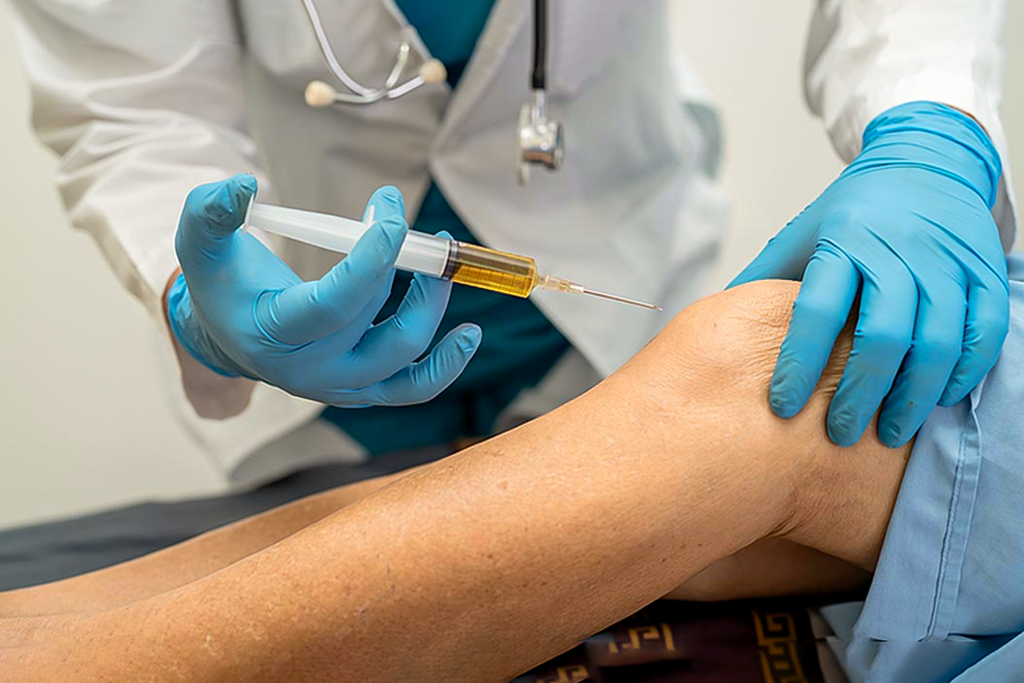PRP Injections for Knee Pain: A Revolutionary Treatment Option

PRP Injections for Knee Pain: A Revolutionary Treatment Option Facebook Twitter Youtube Instagram Knee pain and tendon pain can be agonizing and not all times traditional techniques help. Knee pain is a frequent issue for athletes, often stemming from ligament strains, cartilage injuries, and tendonitis, as well as for individuals over 50 dealing with knee arthritis. What You Need to Know PRP injections offer effective support for wound healing in trauma and joint injuries. Results from PRP injections typically become noticeable within a few weeks for joint treatments. However, the effects are not permanent, and additional injections may be required as advised by a doctor. Since PRP injections utilize a patient’s tissues, they are considered safe and can be used as a standalone treatment or combined with other procedures for enhanced results. Platelet-rich plasma i.e. PRP injections for knee pain have been recognized for their ability to relieve joint pain, decrease inflammation, and enhance overall function. Both traumatic soft tissue injuries and degenerative conditions, such as meniscus deterioration, may benefit from this regenerative approach. PRP therapy is commonly used to treat knee osteoarthritis, tendon damage, patellar tendon injuries, and ligament issues like ACL tears. Research on PRP for knee osteoarthritis has consistently reported significant improvements in symptoms and recovery outcomes. Let’s dive in more to understand how PRP injections for knee pain work, what are the side effects, and when it is used. What is a PRP injection? Platelet-rich plasma is extracted from a patient’s blood sample and then carefully injected into the targeted area, like an injured knee or tendon. In some cases, ultrasound guidance is used to ensure precise placement. The goal is to boost the concentration of growth factors like special proteins and hormones at the site of injury, to accelerate natural healing. What is the procedure of administering a PRP injection? PRP therapy follows a three-step process: Blood Collection – A small amount of blood is drawn from your arm. Platelet Separation – The blood sample is placed in a centrifuge to isolate platelets, creating a concentrated plasma suspension. Injection – A doctor numbs your knee and injects the PRP directly into the joint space, possibly using ultrasound for precision. Why are PRP injections used? PRP injections are used for a variety of treatments, spanning musculoskeletal injuries, post-surgical recovery, and cosmetic procedures. Tendon, Ligament, Muscle & Joint Injuries – Chronic conditions like tennis elbow and jumper’s knee can take a long time to heal. PRP injections help accelerate recovery, reduce pain, and get patients back to their activities faster. Post-Surgical Healing – Originally used in jaw and plastic surgery, PRP injections are now aiding muscle, tendon, and ligament repair, helping patients recover from intensive procedures more efficiently. Osteoarthritis Relief – Early studies suggest PRP may reduce joint inflammation and stiffness, helping patients manage pain and improve mobility. Research is ongoing, but the results are promising. Benefits of taking PRP injections Accelerates healing of joint and sports injuries Reduces pain and inflammation Promotes natural tissue repair Enables faster return to physical activities Delivers noticeable results within a few months Minimally invasive and low risk Uses the patient’s own blood, making it a safe treatment option Suitable for chronic conditions like knee pain, tennis elbow, and jumper’s knee What are the risks and side effects associated with PRP injections for knee pain? PRP injections are generally low-risk and rarely cause major side effects. Since the procedure involves drawing blood, it’s important to stay hydrated and eat beforehand to avoid lightheadedness. Some soreness and bruising at the injection site are common after treatment. Because PRP uses your own plasma, the likelihood of an allergic reaction is much lower compared to other injectable medications like corticosteroids. While rare, potential risks include bleeding, tissue damage, infection, and nerve injuries. Consulting a healthcare professional can help ensure a safe and effective experience. Contact MJ Naidu to Schedule Your PRP Treatment PRP injections tap into your body’s natural healing power, offering safe, effective, and lasting relief from knee pain and stiffness. Whether you’re dealing with osteoarthritis, tendinitis, or other knee-related conditions, PRP injections for knee pain provide a promising, non-surgical solution to restore knee joint mobility and enhance your quality of life. At MJ Naidu, our team specializes in PRP injections to help you move with confidence again. Schedule your appointment today and take the first step toward pain-free living. https://www.youtube.com/shorts/ZIiIexJoeVs Frequently Asked Questions on PRP Injections 1. What is PRP? PRP (Platelet-Rich Plasma) is a concentrated solution of platelets from your own blood, rich in growth factors to promote healing. 2. How does PRP work? It works by injecting concentrated growth factors directly into an injured area, stimulating the body’s natural tissue repair and regeneration processes. 3. What is the PRP procedure? Blood is drawn, spun in a centrifuge to separate PRP, and then the concentrated PRP is precisely injected into the injured area. 4. What are the side effects? Common side effects are mild and temporary: pain, swelling, or bruising at the injection site. Serious complications like infection are rare. 5. How long does it take to work? Post PRP injection administration, the results are visible within 2-6 weeks, with continued improvement over several months, as tissue regeneration is a gradual process. 6. What are the applications for PRP for knee injuries? Common applications include knee osteoarthritis, meniscus tears, mild ligament sprains, and tendinopathies like “jumper’s knee.” Enquire now Relevant Resource : Hairline Fracture Table of Contents What is a PRP injection? What is the procedure of administering a PRP injection? Why are PRP injections used? Benefits of taking PRP injections What are the risks and side effects associated with PRP injections for knee pain? Contact MJ Naidu to Schedule Your PRP Treatment Frequently Asked Questions on PRP Injections MJNaidu hospital latest Updates delivered straight to your inbox Follow Us You have been successfully Subscribed! Ops! Something went wrong, please try again.

